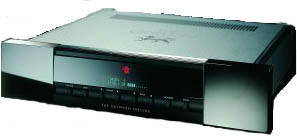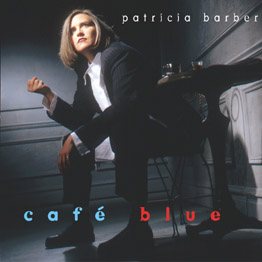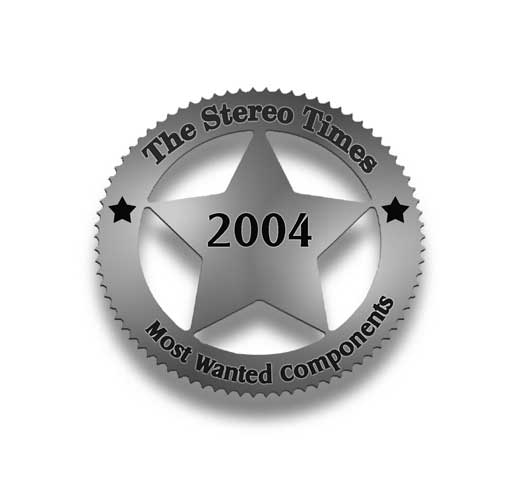Gryphon Audio Encore Stereo Amplifier and Prelude Preamplifier
| Gryphon Audio Encore Stereo Amplifier and Prelude Preamplifier |
|
The Great Danes |
|
Greg Petan |
|
July 2004 |

On my first tour of New York’s audio salons, I came across an amplifier from a manufacturer I had never heard of. This dark, hulking and downright menacing beast appeared to grip the floor with hidden claws. Rays of glowing red light illuminated the innards of what conjured images of the intestinal tract of some brutish mythical creature.
As I stared bug-eyed at this creation, a salesman approached and said, “That’s the new Gryphon Antileon amplifier from Denmark. Pretty cool huh?” “Yeah, you can say that again,” I responded. “What’s it going for?” Upon hearing the price, reality sobered me up and I was forced to move on. As I walked out the door I thought to myself, “One day…. one day!” (This just so happened to be the very same store that our own Clement Perry worked at, at the time.)
Twelve years later, that day arrived. A call from Clement Perry heralded the arrival of the latest products from Gryphon; the Encore amplifier and Prelude preamp. After a subsequent audition and much arm-twisting, Clement agreed to let me handle the review of both the Encore and Prelude (the Mikado CD player was crazy glued to his equipment rack!).
For those who have not seen Gryphon products before, I encourage you to visit their web site, www.gryphonaudio.com.The visual antithesis of the much beloved Jeff Rowland amplifiers I have been so enamored with, the Encore is a stunning combination of black steel and chunky acrylic. With a glowing red logo on the faceplate and the signature subtle internal illumination, the Encore is more “Lord of the Rings” while the Rowland is more “Sex and the City”.
Being a true dual mono design, the Encore requires two power chords. This presents a probable financial challenge when considering the after market power cords you will surely want to try. I was very fortunate to have access to Elrod Power Systems Statement power cords. At $2,400 a pop, they make for a very expensive addition to the Encore. But man-o-man I got to tell you, in the world of price to performance ratio’s spinning ridiculously out of control, in the high end, (wait, is this me saying this?) the Statements prove their worth and then some.
When turned on, the Encore goes through a booting up process. A flashing red “mute” is illuminated until the amplifier has run through its microprocessor based system analysis. Once the check for DC, temperature, and phase has been given a complete bill of health, the outputs are activated. I allowed the unit to run the mandatory 100 hours or so with the help of my cable television audio signal running through it when I was not listening to music (before the hundred hour mark, the Encore is rather dark and lacking frequency extension). The rear panel accommodates balanced as well as single-ended inputs. There is only one set of binding posts, which left me wanting. I like to have the extra set even if I have no immediate need.
Rock Me I’m a Dane(ish)
Aside from that brief encounter with Gryphon some twelve years before, my only real exposure to Gryphon came at the 2003 CES. An Antileon stereo amp was driving the new Cantata speakers with a signal provided by a then prototype Mikado CD player. The sound was awesome. Fast, open, and harmonically right. Yet, despite those observations, I really didn’t know what to expect from the lower priced, higher powered Encore.
So it was a real joy when I really let my ears hang out on the Encore. It took little time to realize that the Encore was the scratch that went straight to my audiophile itch. I was immediately struck by the command and control imparted by the Encore upon the Talon Audio Firebirds’ woofers. Music took on a big, bold presence with a fantastically robust and layered stage. There is a stability of imaging and dynamic control that is just so confidence inspiring. No matter how loud or soft the musical passage, or how much bass information, the Encore secures the image in space with spot-welded certainty. 500 watts per channel can do that for you.
But it is not just watts that define the Encore. There are plenty of amps that can deliver big power. It‘s the heart of the midrange that really sets the Encore apart. Here is an amp that will throw its weight around and render tonal color in a way that strikes an ideal balance. Instrumental timbre and voices are passed with a vanishingly low level of solid-state artifice. The Encore will not pollute the signal with any grit, grain or grunge found in solid-state amplifiers of the past. The result is an image of density, color and discreet separation from its surroundings.
Like other great high end products such as the recently reviewed Talon Audio Firebird loudspeakers and the Silversmith Palladium wire system, the Encore relieves the unconscious mind from the burden of separating the musical wheat from the distorted chaff. Sinking into and staying in the flow of the music comes effortlessly. What’s even better is that the Encore is not limited to any particular musical genre. The delicate classical music structures found on Mozart Sinfonia Concertante [Gramaphone 453 044-2] in contrast to the cataclysmic eruption midway through the “Romeo is Bleeding” soundtrack [Verve 414 521 231] are rendered with equal aplomb.
Sinking into and staying in the flow of the music comes effortlessly. What’s even better is that the Encore is not limited to any particular musical genre. The delicate classical music structures found on Mozart Sinfonia Concertante [Gramaphone 453 044-2] in contrast to the cataclysmic eruption midway through the “Romeo is Bleeding” soundtrack [Verve 414 521 231] are rendered with equal aplomb.  This last disc will tell you more than you may care to know about your systems ability to hold it all together when the dynamic going gets rough. The contrasting textures, hard imaging pans and dynamic headroom should all be stable and clearly defined. Despite the mayhem, the signal should not collapse into ear folding distortion. With the Encore, and for the first time to this degree, that’s exactly what I got.
This last disc will tell you more than you may care to know about your systems ability to hold it all together when the dynamic going gets rough. The contrasting textures, hard imaging pans and dynamic headroom should all be stable and clearly defined. Despite the mayhem, the signal should not collapse into ear folding distortion. With the Encore, and for the first time to this degree, that’s exactly what I got.
The bass, as I alluded to earlier, was a clear, indisputable step up from the Rowland 302. Not surprising given the disparity in the power ratings. Where the Rowland has great transparency down into the bass, the Encore shows it to be rather threadbare and reticent. The Encore’s full, powerful bass sounded more like the Krell FPB700cx yet more naturally rendered than the Krell in both purity, in texture and color.
The treble may be the area that may cause some debate. As I mentioned earlier, the Encore will add no edge or glare of its own. The presentation is super smooth yet finely detailed (The inclusion of Ralph Dodson’s phenomenal Model DA 218 made this last observation a slam dunk). There does seem, however to be a slight darkening from the lower treble down through the upper midrange that gives the Encore a slightly tipped down balance. This suits me just fine as there is no obfuscation of detail as a result.
I drew this conclusion by comparison to the Rowland 302, an amplifier that in my opinion has a tipped up balance. Depending on your system, either of these amps may fill the bill. Though for my system and taste, the Encore easily takes the coveted yellow jersey.
Enter the Prelude
Mid way through my review of the Encore, I came into possession of Gryphon’s new $9,000 Prelude preamplifier. The Prelude is the natural partner for the Encore as both products were developed in tandem and produce a striking, potent combination. Styled to match the Encore, the Prelude utilizes push button controls on it’s faceplate rather than knobs. The ability to cycle through all five input options (Input “3” can be set as a throughput for AV processors), volume adjustment, mute, standby and power are repeated on the weighty machined steel remote. Like the Encore there is a subtle laser etched Gryphon logo on the top plate giving the both products a sense of pedigree. In the same breath, I wish the top covers of both the Encore and the Prelude were of a heavier gauge of steel. The Cover of the Encore in particular rang like a bell when my fingers strummed across the vents etched across the top. At these prices, I expect more.

Unlike the Encore, out of the box the Prelude, through the balanced connections, sounded cold, flat and rather forward. The bass however had a sense of grip, extension and power that floored me. I really hoped the Prelude would transform with time, and it did. The midrange ripened, the treble sweetened and gratefully, the bass retained its incredible dynamics and power.
The fact that the Prelude made a pretty dramatic transformation does not mean that it could be confused with a tube preamp, or my reference Rowland Coherence. The Prelude is all about precision and articulation. Everything that I played through the Prelude took on a new sense of order and specificity.  Densely rendered recordings such as Sibelius Violin Concerto [Gramaphone 447 895-2] found a dynamic vitality and illumination into the spaces between and around all the instrumental lines. After years with the Rowland Coherence in my system, the “matter of fact” neutrality of the Prelude took some getting used to. The Rowland Coherence while very articulate and open sounds more reticent and softer edged then the Prelude. The Rowland possesses unparalleled mid-range dimension and warmth for a solid-state preamp, but the Prelude opens up the bass and mid-bass showing the Rowland to be the slightest bit diffused and colored by comparison.
Densely rendered recordings such as Sibelius Violin Concerto [Gramaphone 447 895-2] found a dynamic vitality and illumination into the spaces between and around all the instrumental lines. After years with the Rowland Coherence in my system, the “matter of fact” neutrality of the Prelude took some getting used to. The Rowland Coherence while very articulate and open sounds more reticent and softer edged then the Prelude. The Rowland possesses unparalleled mid-range dimension and warmth for a solid-state preamp, but the Prelude opens up the bass and mid-bass showing the Rowland to be the slightest bit diffused and colored by comparison.
Dynamics are another great strength of the prelude. There is a “jump factor” provided by the Prelude that makes listening to music far less passive and far more edge-of-your-seat exiting. The sonic cost for all this fun is the last vestige of subtle dynamic shading. There seem to be fewer discreet steps between double pianissimo, and pianissimo for instance. I would imagine its big brother the Sonata Allegro preamp fills in these subtle gaps.
And Then …
A visit from Clement Perry coincided with the arrival of the Shunyata Research Anaconda power cord. We Replaced my old standby, a first generation Synergistic Research Master Coupler on my Linn Sondek CD12 and sat down for a listen. Jumpin’ Jeehosafat!! The system just ripped! With Clement’s mix of tunes he whipped up for me on a CDR spinning in the CD12 the fun really started. “Nardis” from Patricia Barber’s Café Blue [Premonition 21810] featuresMark Walker on a drum solo that lets loose with some outrageously dynamic cymbal work. Through the Prelude, there is a sense of effortless dynamic headroom. Ultimately though, this is the area that poses the real challenge for the Prelude. Vocals such as Nora Jones’, with her rather gentile vocal delivery, are punctuated by some serious dynamics. Compared to the Rowland Coherence, the Prelude slightly hardened the peak of the dynamics taking me out of the flow of the music. This criticism is lessened by experimenting with tweaks such as the Disc of Silence from SolidTech.
With Clement’s mix of tunes he whipped up for me on a CDR spinning in the CD12 the fun really started. “Nardis” from Patricia Barber’s Café Blue [Premonition 21810] featuresMark Walker on a drum solo that lets loose with some outrageously dynamic cymbal work. Through the Prelude, there is a sense of effortless dynamic headroom. Ultimately though, this is the area that poses the real challenge for the Prelude. Vocals such as Nora Jones’, with her rather gentile vocal delivery, are punctuated by some serious dynamics. Compared to the Rowland Coherence, the Prelude slightly hardened the peak of the dynamics taking me out of the flow of the music. This criticism is lessened by experimenting with tweaks such as the Disc of Silence from SolidTech.
Throughout the review process, the Prelude’s strengths remained while its limitations were marginalized. With the Prelude’s open, illuminated upper midrange and treble, there is a sense that the slight darkening of the Encore drifted closer to true neutrality – whatever that is! Like most high-end components, the Prelude and Encore gives their best performance when you give them your best efforts and attention.
Conclusion
 Just when I was settling in for the long haul with my Rowland 302, along comes a left hook in the form of this 500 watts of Danish ingenuity, the Gryphon Encore. With its full bodied, iron-fisted control and downright seductive midrange, I was set scrambling, searching for the ropes to hold up my battered audiophile sensibilities. Hooked up to the Talon Firebirds, I have found a special, musical/electronic partnership.
Just when I was settling in for the long haul with my Rowland 302, along comes a left hook in the form of this 500 watts of Danish ingenuity, the Gryphon Encore. With its full bodied, iron-fisted control and downright seductive midrange, I was set scrambling, searching for the ropes to hold up my battered audiophile sensibilities. Hooked up to the Talon Firebirds, I have found a special, musical/electronic partnership.
As for the Prelude preamplifier, we had to spar a few rounds before I came around to truly appreciate its special way with an audio signal. The Prelude offers a potent punch with its vanishing levels of sonic coloration and dynamic low-end extension. The ability to work it into your system with little effort will depend on your systems existing balance. The good news is that the Prelude passed on the improvements made upstream with little effort proving that it will only get better as the components and cords that surround it are upgraded.
Hunt these products from Denmark down and give them a serious listen. It doesn’t get much better than this.
Manufacturers Response:
Dear Stereotimes
The Gryphon team would like to thank Greg and Stereotimes for the wonderful balanced review of the Gryphon Prelude and Encore. Gregs observations are very precise and his ability to peel off the skins of all the obvious and get into the soul of the product is impressive. We take great pride in all our products but realize that people who likes them, may like them for other reasons than ours. It is just so gratifying when we hear that someone likes the products for the same reasons as we do.
Allow me to make a single correction – the covers are made of Aluminum, not steel as Greg mention..
Thank you again from the happy Danes at Gryphon
Flemming E. Rasmussen
CEO
Specifications:
Gryphon Encore Power Amplifier
Output Power: 2×500 watts into 4 ohms, 2×1000 watts into 8 ohms (per channel RMS).
S/N unweighted: 20-20.000 Hz: better than 85 db Distortion: Less than 0.1% at 200w.
Input sensitivity: 1.5v Gain: +32 dB
Frequency Bandwidth: 0 – 350 KHz
Channel Separation: Better than 120 dB
Input impedance: 20-20KHz Balanced, 20KOhm Single ended, 8 KOhm
Output Impedance: 20-20KHz 0.056 Ohms
Speaker outputs: 1 set 3 way Gryphon terminals
Power Supply Capacity: 160.000 MicroFarad
Power Consumption: 2500 w maximum, 350 w minimum
Dimensions: 48x26x51 (WxHxD/cm.)
Unit Weight: 48 Kgs
Shipping Weight: 75 Kgs
Price: $14,000
Gryphon Prelude Preamplifier
Frequency Response: 0.2 Hz – 2 MHz + 0 / – 3 dB
Input Impedance: Balanced= 20 KOhm, Single Ended= 10 KOhm
AV Input=10 KOhm
THD + N: -0.006% 1 KHz
Gain: 17.5 dB to 11.5 dB Internally selectable
Output Voltage: Balanced 23.0 Vrms; Single Ended 11.5 Vrms
Output Impedance 20 Ohm
Size: (WxHxD) 48 x 13 x38 cm.
Weight: 9 Kg. net
Price: $9,000
Gryphon Audio Designs
Industrivej 9
8680 Ry
Denmark
Tel: (45) 86891200
Fax: (45) 86891277
E-mail: Sales@Gryphon-audion.dk
![]()
Don’t forget to bookmark us! (CTRL-SHFT-D)
Stereo Times Masthead
Publisher/Founder
Clement Perry
Editor
Dave Thomas
Senior Editors
Frank Alles, Mike Girardi, Russell Lichter, Terry London, Moreno Mitchell, Paul Szabady, Bill Wells, Mike Wright, and Stephen Yan,
Current Contributors
David Abramson, Tim Barrall, Dave Allison, Ron Cook, Lewis Dardick, John Hoffman, Dan Secula, Don Shaulis, Greg Simmons, Eric Teh, Greg Voth, Richard Willie, Ed Van Winkle, Rob Dockery, Richard Doron, and Daveed Turek
Site Management Clement Perry
Ad Designer: Martin Perry





Be the first to comment on: Gryphon Audio Encore Stereo Amplifier and Prelude Preamplifier